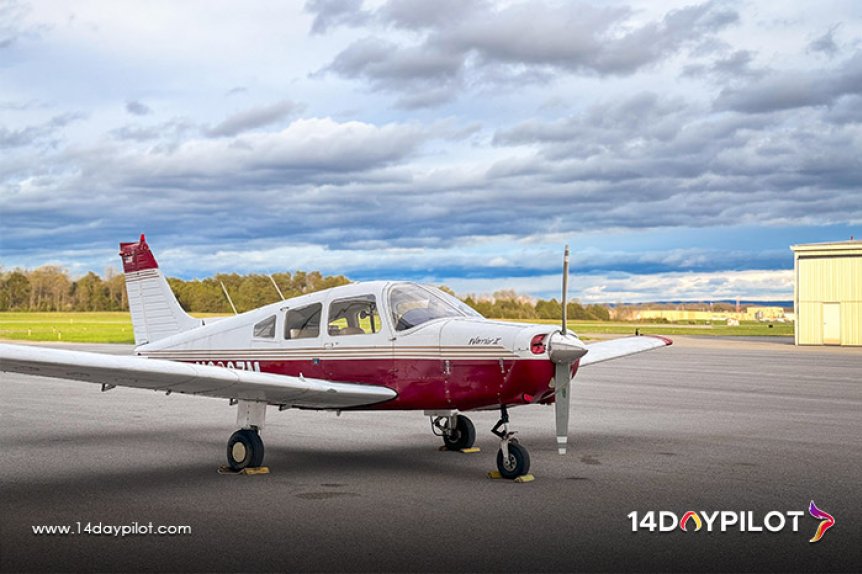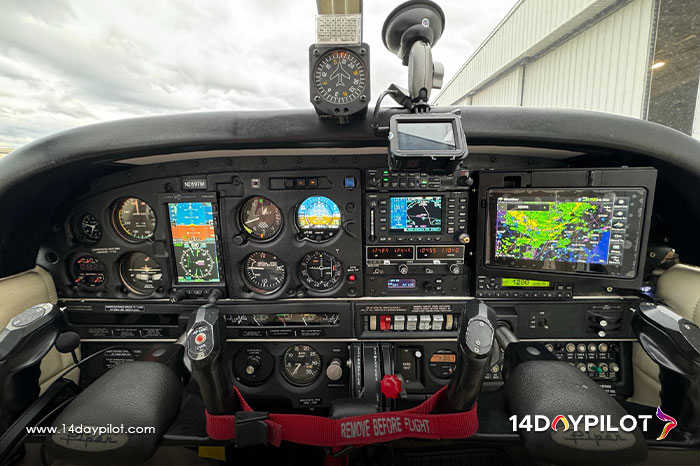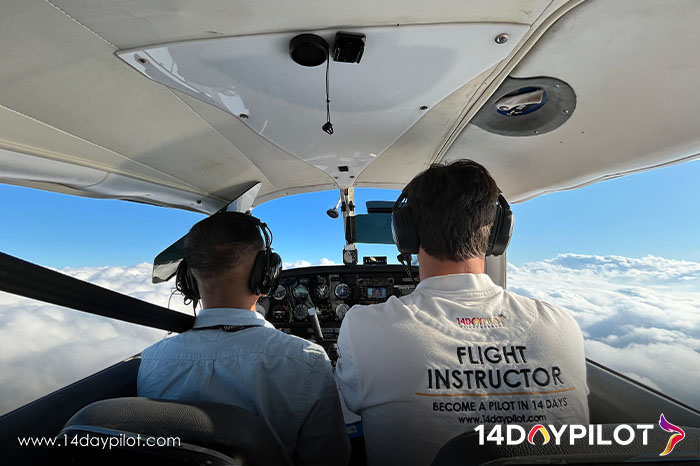
At 14DAYPILOT Flight Academy, we incorporate TAAs into our rigorous training programs, ensuring students are ready for real world airline operations. Discover how TAA shapes commercial pilot training, meets FAA requirements, and provides aspiring aviators with essential skills for their careers.

Technically Advanced Airplanes Cockpit N2897M 14DAYPILOT Fleet
(Source Image: Documentation by 14DAYPILOT)
Flight training has evolved from traditional analog cockpit aircraft to glass cockpit technology, which provides increased situational awareness, automation, and safety enhancements. The FAA defines a technically advanced airplane (TAA) under 14 CFR 61.1 as an aircraft equipped with:
A primary flight display (PFD)
A multi-function display (MFD) with moving map navigation
A two-axis autopilot system
This shift reflects the broader aviation industry's transition to automation-driven flight systems, making it imperative for commercial pilots to train with the latest technology.
Read More: Cedrych’s Flight Success: 20 Years Waiting, 14 Days to Pilot
A technically advanced airplane is designed with integrated avionics, autopilot capabilities, and digital flight systems, which enhance operational efficiency and safety. Unlike older analog systems, TAAs use digital instrumentation that mirrors what pilots will encounter in airline careers.

Student Training in Technically Advanced Airplane
(Source Image: Documentation by 14DAYPILOT)
Training with technically advanced airplane prepares aspiring commercial pilots for real-world airline operations in several ways:
TAA training introduces pilots to glass cockpit avionics, preparing them for modern commercial aircraft like the Boeing 737 or Airbus A320.
Automation tools such as autopilot, synthetic vision, and terrain mapping reduce pilot workload, increasing safety during flights.
Since commercial airlines utilize highly automated aircrafts, training in a TAA provides students with a seamless transition to airline environments.
To qualify as TAA-compliant, an aircraft must have a PFD, MFD, and autopilot system as defined by the FAA. These features prepare pilots for modern commercial cockpits by developing their proficiency with digital avionics.
To obtain a commercial pilot certificate, pilots must meet the FAA’s requirements, which include:
Logging at least 250 flight hours (for Part 61) or meeting Part 141 structured program requirements.
Completing a commercial cross-country flight with specific distance and time criteria.
Demonstrating proficiency in complex or technically advanced aircraft.
With FAA regulations now emphasizing TAA equivalency for commercial pilot applicants, students training with TAA meet these requirements while gaining critical skills for airline careers.
Read More: Struggling to Fly? See How Gary Got His Pilot License Fast!
Training in a TAA provides multiple benefits, including:
Improved Pilot Precision: Digital displays and automation reduce human error and improve accuracy in navigation and flight control.
Faster Learning Curve: Pilots transition quickly to airline cockpits by developing digital avionics proficiency.
Better Job Prospects: Airlines prioritize pilots with experience in TAA, ensuring a smoother transition to commercial operations.
Increased Safety: Synthetic vision, real-time weather updates, and terrain mapping enhance in-flight decision-making.
These advantages make TAA training an integral part of a modern commercial pilot training program.
At 14DAYPILOT, we recognize the significance of training with cutting-edge aircraft technology. Our 5 Day FAA Accelerated Commercial Pilot Training Program incorporates TAA to ensure our students receive top-tier training that aligns with industry demands. Our approach includes:
Personalized Flight Training: Hands-on experience with modern TAA-equipped aircraft.
Simulated Airline Operations: Realistic airline-style training for a smooth transition to professional aviation careers.
Compliance with FAA Regulations: Ensuring all students meet or exceed FAA requirements for commercial pilots.
Training with technically advanced airplane is no longer optional, it is a necessity for pilots aiming to thrive in the airline industry. 14DAYPILOT provides a premier learning experience, ensuring that every student is prepared to operate modern commercial aircraft with confidence and competence.
Aspiring commercial pilots who train with TAA gain a competitive edge, setting them up for long-term success in their aviation careers. Are you ready to take your pilot training to the next level? Book your flight schedule with our TAA and experience the future of aviation firsthand!

A Technically Advanced Airplane (TAA) is revolutionizing the aviation industry by enhancing pilot training and safety. As technology rapidly evolves, it plays a critical role in improving pilot preparedness. One of the key advancements is the integration of TAA into commercial pilot training. With the Federal Aviation Administration (FAA) refining regulations to incorporate modern technology, understanding the impact of TAAs on pilot preparation is vital.
At 14DAYPILOT Flight Academy, we incorporate TAAs into our rigorous training programs, ensuring students are ready for real world airline operations. Discover how TAA shapes commercial pilot training, meets FAA requirements, and provides aspiring aviators with essential skills for their careers.

Technically Advanced Airplanes Cockpit N2897M 14DAYPILOT Fleet
(Source Image: Documentation by 14DAYPILOT)
Flight training has evolved from traditional analog cockpit aircraft to glass cockpit technology, which provides increased situational awareness, automation, and safety enhancements. The FAA defines a technically advanced airplane (TAA) under 14 CFR 61.1 as an aircraft equipped with:
A primary flight display (PFD)
A multi-function display (MFD) with moving map navigation
A two-axis autopilot system
This shift reflects the broader aviation industry's transition to automation-driven flight systems, making it imperative for commercial pilots to train with the latest technology.
Read More: Cedrych’s Flight Success: 20 Years Waiting, 14 Days to Pilot
A technically advanced airplane is designed with integrated avionics, autopilot capabilities, and digital flight systems, which enhance operational efficiency and safety. Unlike older analog systems, TAAs use digital instrumentation that mirrors what pilots will encounter in airline careers.

Student Training in Technically Advanced Airplane
(Source Image: Documentation by 14DAYPILOT)
Training with technically advanced airplane prepares aspiring commercial pilots for real-world airline operations in several ways:
TAA training introduces pilots to glass cockpit avionics, preparing them for modern commercial aircraft like the Boeing 737 or Airbus A320.
Automation tools such as autopilot, synthetic vision, and terrain mapping reduce pilot workload, increasing safety during flights.
Since commercial airlines utilize highly automated aircrafts, training in a TAA provides students with a seamless transition to airline environments.
To qualify as TAA-compliant, an aircraft must have a PFD, MFD, and autopilot system as defined by the FAA. These features prepare pilots for modern commercial cockpits by developing their proficiency with digital avionics.
To obtain a commercial pilot certificate, pilots must meet the FAA’s requirements, which include:
Logging at least 250 flight hours (for Part 61) or meeting Part 141 structured program requirements.
Completing a commercial cross-country flight with specific distance and time criteria.
Demonstrating proficiency in complex or technically advanced aircraft.
With FAA regulations now emphasizing TAA equivalency for commercial pilot applicants, students training with TAA meet these requirements while gaining critical skills for airline careers.
Read More: Struggling to Fly? See How Gary Got His Pilot License Fast!
Training in a TAA provides multiple benefits, including:
Improved Pilot Precision: Digital displays and automation reduce human error and improve accuracy in navigation and flight control.
Faster Learning Curve: Pilots transition quickly to airline cockpits by developing digital avionics proficiency.
Better Job Prospects: Airlines prioritize pilots with experience in TAA, ensuring a smoother transition to commercial operations.
Increased Safety: Synthetic vision, real-time weather updates, and terrain mapping enhance in-flight decision-making.
These advantages make TAA training an integral part of a modern commercial pilot training program.
At 14DAYPILOT, we recognize the significance of training with cutting-edge aircraft technology. Our 5 Day FAA Accelerated Commercial Pilot Training Program incorporates TAA to ensure our students receive top-tier training that aligns with industry demands. Our approach includes:
Personalized Flight Training: Hands-on experience with modern TAA-equipped aircraft.
Simulated Airline Operations: Realistic airline-style training for a smooth transition to professional aviation careers.
Compliance with FAA Regulations: Ensuring all students meet or exceed FAA requirements for commercial pilots.
Training with technically advanced airplane is no longer optional, it is a necessity for pilots aiming to thrive in the airline industry. 14DAYPILOT provides a premier learning experience, ensuring that every student is prepared to operate modern commercial aircraft with confidence and competence.
Aspiring commercial pilots who train with TAA gain a competitive edge, setting them up for long-term success in their aviation careers. Are you ready to take your pilot training to the next level? Book your flight schedule with our TAA and experience the future of aviation firsthand!
Hawra Tustari is an active aviation blogger who has high interest and expectations for the aviation industry. She is also an FAA Private Pilot who currently on a training to upgrade her licenses. Always up to date with the latest aviation news, Hawra aims to provide the best content on our website to help all pilots alike. We aim to provide flight training guidance and with information related to flying school materials and tips involved how to pass the check ride for all students.
Hawra Tustari is an active aviation blogger who has high interest and expectations for the aviation industry. She is also an FAA Private Pilot who currently on a training to upgrade her licenses. Always up to date with the latest aviation news, Hawra aims to provide the best content on our website to help all pilots alike. We aim to provide flight training guidance and with information related to flying school materials and tips involved how to pass the check ride for all students.